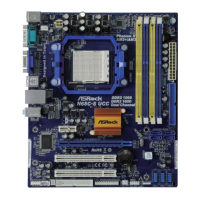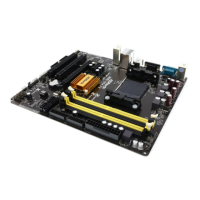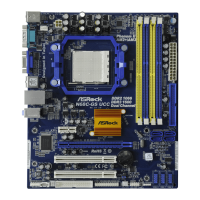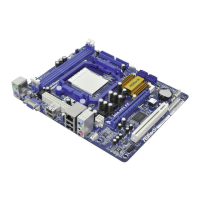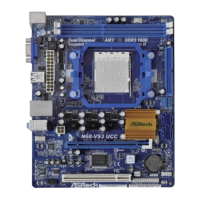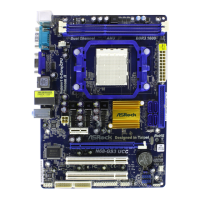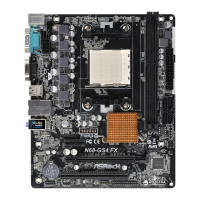Do you have a question about the ASROCK N68C-S and is the answer not in the manual?
Lists the items included with the ASRock N68C-S motherboard.
Details the technical specifications of the motherboard, including CPU, memory, and expansion slots.
Illustrates the physical layout of the motherboard components and connectors.
Describes the rear panel input/output ports for connecting peripherals.
Step-by-step guide for installing the Central Processing Unit onto the motherboard socket.
Instructions for mounting the CPU cooling fan and heatsink for proper heat dissipation.
Details the process for installing DDR2 and DDR3 memory modules, including dual channel configuration.
Explains the use and installation of PCI and PCI Express expansion cards.
Guide for setting up a multi-monitor display environment using onboard and add-on graphics.
Instructions on configuring motherboard jumpers for specific system settings.
Identifies and explains the purpose of various onboard headers and connectors on the motherboard.
Provides guidance on setting up SATAII hard disks for optimal performance.
Step-by-step instructions for installing SATA and SATAII hard disks.
Explains the Hot Plug and Hot Swap functionalities for SATA/SATAII HDDs.
Details the procedure and precautions for using the Hot Plug feature with SATA/SATAII HDDs.
Guidance on installing system drivers from the support CD.
Instructions for installing Windows operating systems without RAID configuration.
Instructions for installing Windows operating systems with RAID configuration.
Explains the Untied Overclocking Technology for improved system performance.
Introduces the BIOS Setup Utility and how to access it.
Describes the system overview displayed on the main BIOS setup screen.
Details the options available in the OC Tweaker screen for overclocking.
Covers advanced system configurations including CPU, Chipset, and ACPI settings.
Monitors system hardware status like temperature, fan speed, and voltage.
Configures system boot settings and boot priority.
Allows setting and changing system supervisor/user passwords.
Options for saving or discarding changes and exiting the BIOS setup.
Provides guidance on installing supported Microsoft Windows operating systems.
Information about the contents of the support CD, including drivers and utilities.
Lists the items included with the ASRock N68C-S motherboard.
Details the technical specifications of the motherboard, including CPU, memory, and expansion slots.
Illustrates the physical layout of the motherboard components and connectors.
Describes the rear panel input/output ports for connecting peripherals.
Step-by-step guide for installing the Central Processing Unit onto the motherboard socket.
Instructions for mounting the CPU cooling fan and heatsink for proper heat dissipation.
Details the process for installing DDR2 and DDR3 memory modules, including dual channel configuration.
Explains the use and installation of PCI and PCI Express expansion cards.
Guide for setting up a multi-monitor display environment using onboard and add-on graphics.
Instructions on configuring motherboard jumpers for specific system settings.
Identifies and explains the purpose of various onboard headers and connectors on the motherboard.
Provides guidance on setting up SATAII hard disks for optimal performance.
Step-by-step instructions for installing SATA and SATAII hard disks.
Explains the Hot Plug and Hot Swap functionalities for SATA/SATAII HDDs.
Details the procedure and precautions for using the Hot Plug feature with SATA/SATAII HDDs.
Guidance on installing system drivers from the support CD.
Instructions for installing Windows operating systems without RAID configuration.
Instructions for installing Windows operating systems with RAID configuration.
Explains the Untied Overclocking Technology for improved system performance.
Introduces the BIOS Setup Utility and how to access it.
Describes the system overview displayed on the main BIOS setup screen.
Details the options available in the OC Tweaker screen for overclocking.
Covers advanced system configurations including CPU, Chipset, and ACPI settings.
Monitors system hardware status like temperature, fan speed, and voltage.
Configures system boot settings and boot priority.
Allows setting and changing system supervisor/user passwords.
Options for saving or discarding changes and exiting the BIOS setup.
Provides guidance on installing supported Microsoft Windows operating systems.
Information about the contents of the support CD, including drivers and utilities.
| Non-ECC | Yes |
|---|---|
| Number of memory slots | 4 |
| Maximum internal memory | 8 GB |
| Processor socket | Socket AM3 |
| Processor manufacturer | AMD |
| USB 2.0 connectors | 3 |
| Number of Parallel ATA connectors | 1 |
| PS/2 ports quantity | 2 |
| USB 2.0 ports quantity | USB 2.0 ports have a data transmission speed of 480 Mbps, and are backwards compatible with USB 1.1 ports. You can connect all kinds of peripheral devices to them. |
| Firewire (IEEE 1394) ports | 0 |
| Certification | FCC, CE, WHQL |
| Power source type | ATX |
| Audio output channels | 5.1 channels |
| Motherboard form factor | micro ATX |
| Compatible operating systems | Windows 7, Vista, XP |
| Graphics card | GeForce 7025 |
| Maximum graphics card memory | 256 MB |
| RAID levels | 0, 1, 0+1 |
| Networking features | 10/100 Mbps |
| ACPI version | 1.1 |
| BIOS memory size | 64 Mbit |
| Depth | 208 mm |
|---|---|
| Width | 244 mm |

